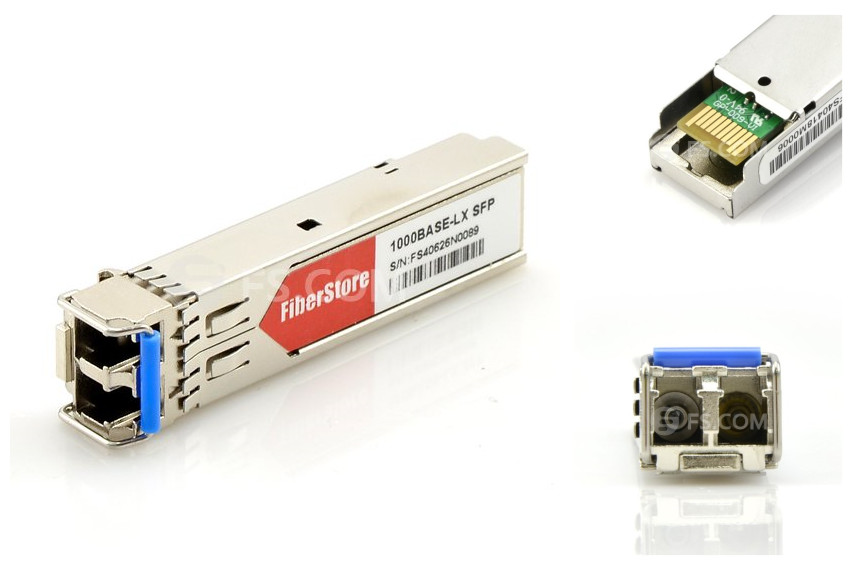June 08, 2016
SFP (small form-factor pluggable) was jointly developed by many of the world's leading network vendors. It has been widely used in optical network systems. Nowadays, many 3rd party SFP module vendors are providing high quality and reliable compatible SFP transceiver modules with low prices, such as compatible Cisco gigabit SFP, and using 3rd party SFP modules seems to be more and more popular now. Whether to choose compatible SFP modules or not? Here are some common questions that you might ask when using compatible SFP transceivers. Hope these answers can help you get a better understanding of compatible SFP modules.
1000BASE-T is Gigabit Ethernet on copper cables, using four pairs of Category 5 unshielded twisted pair to achieve the gigabit data rate. 1000BASE-T can be used in data centers for server switching, for uplinks from desktop computer switches, or directly to the desktop for broadband applications. A big advantage of 1000BASE-T is that existing copper cabling can be used instead of having to rewire with optical fiber. 1000BASE-X is a group of standards for Ethernet physical layer standards, specified within the IEEE 802.3.z standard. It is used for Gigabit Ethernet connections that transmit data mainly over fiber optic cable. The standards that apply to the term 1000BASE-X include -LX, -SX, -BX10, -LX10, as well as non-standard -ZX and -EX standards. All of the standards that are grouped at 1000BASE-X utilize a 8b/10b encoding where 8 bits are reserved for data transmission while 2 bits are used for error correction.
Each module holds its own information in EEPROM, and this memory is coded with unique identifiers such as part numbers and manufacturers details. The firmware of the host device then checks the memory for the correct information to confirm compatibility.
This is a common problem, a large amount of host devices do not have a firmware check for compatibility, this is known as an "open platform". Many SFP transceivers are sold as compatible when in fact they are open platform. They will work in many host devices but not in any that require coded transceivers. OEM SFP transceivers are coded specifically to suit each host device to avoid this problem, such as HP J4859C (as shown below) and HP JD118B SFP modules.

No, host device warranty will be unaffected. Please note that host device warranties do not cover SFP transceiver modules, OEM vendors offer lifetime warranties to protect them.
DOM, short for digital optical monitoring, is a feature used to monitor some parameters of the transceiver in real-time, helping to identify the location of the fiber link failure, simplify maintenance, and improve system reliability. DOM allows you to monitor the TX (transmit) and RX (receive) power of the module, temperature, and transceiver supply voltage. With DOM, network administrators can check and ensure that the module is functioning correctly in an easy and convenient way. This is why most of modern optical SFP transceivers support DOM functions.
In fact, most of the networking manufacturers do not produce their own SFP, XFP, SFP+, X2 transceivers, etc. They buy OEM transceivers, label them with their own brand and sell at a much higher price. You are basically paying a high price to have the respective manufacturers logo on the equipment. Besides, many compatible transceivers are made and assembled in exactly the same plants assembling officially-branded transceivers. There is almost no big difference between an official transceiver and a third-party plug, aside from the branding and about two hundred to a few thousand bucks.
Here are three methods. First one is appearance recognition. Check the appearance of the SFP module. A new SFP module's appearance generally has good consistency while a refurbished SFP module is not glossy, and has some wear and scratches in the rim angle. Many refurbished SFP modules are replaced with new shells. If there is dust in the interface or the interface is not smooth, it is refurbished SFP module. Then you can check the ferrule. Pulling out the dust cap, you can see the ferrule in the bore. A second-hand old module is not glossy, and generally rough and with scratches, and it has a bad consistency. The ferrules of a new quality module is bright with color and lustre and has a good consistency. Last, you can put the module under the status of 50-60°C and see whether it can work properly. In general, a refurbished SFP module can not work well or even disconnect.
Various vendor-coded SFP modules are compatible to widespread networking equipment from well-known manufacturers. Fiberstore provides a variety of SFP transceiver modules that are compatible to devices of important vendors in the market. From production to shipmet, all these compatible SFP modules are tested and guaranteed 100% compatible and with high qulity.
Posted by: jowang at
02:05 AM
| No Comments
| Add Comment
Post contains 847 words, total size 6 kb.
35 queries taking 0.0147 seconds, 70 records returned.
Powered by Minx 1.1.6c-pink.









